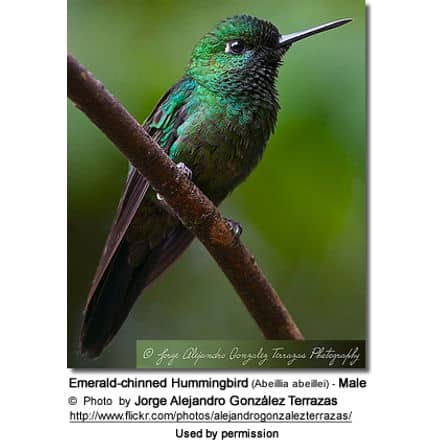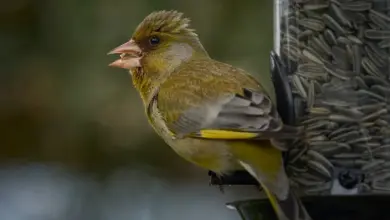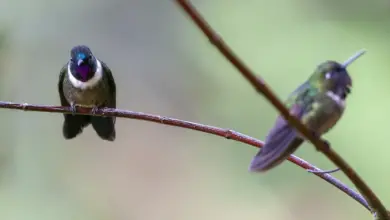Emerald-chinned Hummingbirds
Hummingbird Information
Overview … Alternate (Global) Names
Distribution / Habitat … Subspecies, Ranges and ID
Description … Calls / Vocalizations
Breeding / Nesting … Diet / Feeding
The Emerald-chinned Hummingbirds (Abeillia abeillei) – also known as Abeille’s Hummingbirds – are found in Central America, where they have a wide range. Unfortunately, the numbers of these hummingbirds are believed to be declining due to destruction of their forest habitats.
Distribution / Habitat
They occur naturally in southern Mexico, Belize, El Salvador, Guatemala, Honduras and Nicaragua, where they inhabit subtropical or tropical moist montane forests and heavily degraded former forest.
Subspecies and Ranges
Emerald-chinned Hummingbird (Abeillia abeillei abeillei – Lesson and Delattre, 1839) – Nominate form
Range: Southeastern Mexico south through Guatemala and Belize to El Salvador and northern Honduras.
Emerald-chinned Hummingbird (aurea) (Abeillia abeillei aurea – Miller, W and Griscom, 1925) – validity of this race is sometimes questioned and this form may be merged with nominate race in the future
Range: Southern Honduras and northern Nicaragua.
Description
Size
The Emerald-chinned Hummingbirds measures between 2.8 – 3 inches (7 – 7.6 cm) and averages a weight of 0.10 oz or 2.8 grams.
Plumage Details / Adults
The back and the outer rectrices (the long flight feathers of the tail) are bright metallic bronze green or greenish bronze. The central tail feathers are blue and the rest of the tail is blackish with grey borders. The throat is emerald green. There is a white dot behind each eye.
Other Physical Details
Bill is short and black.
Gender ID
Females resemble males, except are greyer below.
Diet / Feeding
Emerald-chinned Hummingbirds primarily feed on nectar taken from plants of the families Rubiaceae, Verbenaceae, and Oenotheraceae. They use their long, extendible, straw-like tongues to retrieve the nectar while hovering with their tails cocked upward as they are licking at the nectar up to 13 times per second. Sometimes they may be seen hanging on the flower while feeding.
Many native and cultivated plants on whose flowers these birds feed heavily rely on them for pollination. The mostly tubular-shaped flowers actually exclude most bees and butterflies from feeding on them and, subsequently, from pollinating the plants.
They may visit local hummingbird feeders for some sugar water, or drink out of bird baths or water fountains where they will either hover and sip water as it runs over the edge; or they will perch on the edge and drink – like all the other birds; however, they only remain still for a short moment.
They also take some small spiders and insects – important sources of protein particularly needed during the breeding season to ensure the proper development of their young. Insects are often caught in flight (hawking); snatched off leaves or branches, or are taken from spider webs. A nesting female can capture up to 2,000 insects a day.
Males establish feeding territories, where they aggressively chase away other males as well as large insects – such as bumblebees and hawk moths – that want to feed in their territory. They use aerial flights and intimidating displays to defend their territories.
Breeding / Nesting
As is typical of hummingbirds, the Emerald-chinned Hummingbirds are solitary in all aspects of life other than breeding; and the male’s only involvement in the reproductive process is the actual mating with the female. They neither live nor migrate in flocks; and there is no pair bond for this species.
Most breeding occurs between February and March. Several males perform in leks (communal courtship displays) that involve singing and flying in u-shaped pattern in front of any females in their territories.
A male will separate from the female immediately after copulation. One male may mate with several females. In all likelihood, the female will also mate with several males. The males do not participate in choosing the nest location, building the nest or raising the chicks.
The female is responsible for building the deep, cup-shaped nest out of plant fibers woven together and green moss on the outside for camouflage in a protected location in a shrub, bush or tree. She lines the nest with soft plant fibers, animal hair and feather down, and strengthens the structure with spider webbing and other sticky material, giving it an elastic quality to allow it to stretch to double its size as the chicks grow and need more room. The nest is typically found on a low, thin horizontal branch situated about 3.3 – 33 ft (1 – 3 meters) high in a tree.
The average clutch consists of two white eggs, which she incubates alone, while the male defends his territory and the flowers he feeds on. The young are born blind, immobile and without any down.
The female alone protects and feeds the chicks with regurgitated food (mostly partially-digested insects since nectar is an insufficient source of protein for the growing chicks). The female pushes the food down the chicks’ throats with her long bill directly into their stomachs.
As is the case with other hummingbird species, the chicks are brooded only the first week or two, and left alone even on cooler nights after about 12 days – probably due to the small nest size. The chicks leave the nest when they are about 7 – 10 days old.
Calls / Vocalizations / Sounds
Alternate (Global) Names
Chinese: ???? … Czech: Kolibrík smaragdovohrdlý … Danish: Smaragdstrube … Dutch: Smaragdkeelkolibrie … Finnish: Viherleukakolibri … French: Colibri d’Abeillé, Émeraude, Oiseau-mouche abeille … German: Abeille Kolibri, Smaragdkehlkolibri … Italian: Colibrì gola di smeraldo / mentosmeraldo … Japanese: Kobashihachidori … Norwegian: Smaragdstrupekolibri … Polish: zielaczek … Russian: ?????????? ??????? … Slovak: kolibrík zelenobradý … Spanish: Colibri Barbiesmeralda, Colibrí barbilla esmeralda, Colibrí de Abeillé, Colibrí de Barbilla Esmeralda, Colibrí Gorgiverde, Colibrí Pico Corto … Swedish: Smaragdstrupe
Other Web Resources
Metabolism and Survival and Flight Adaptions – Amazing Facts
Species Research by Sibylle Johnson
Please Note: The articles or images on this page are the sole property of the authors or photographers. Please contact them directly with respect to any copyright or licensing questions. Thank you.






